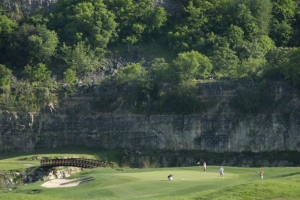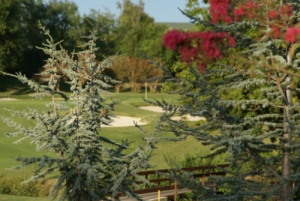Green Golf Courses
by Andrew Boyd
Today, where the grass is always greener. The University of Houston's College of Engineering presents this series about the machines that make our civilization run, and the people whose ingenuity created them.
What sport uses the world's largest maintained playing field? That would be golf. A typical course covers more area than 100 football fields, though only about half of that is manicured grass. Golf courses provide pleasant green space, as housing developers are all too aware. But the voracious need for weed killers, pesticides, fertilizers, and water puts golf courses squarely in the sights of environmentalists.
Today's picture perfect courses are a far cry from the grassy dunes of Scotland where the game originated. Early course maintenance was performed by grazing animals who, together with sea birds, also provided natural fertilizer. The demand for near flawless courses grew with changes in technology. By the end of the twentieth century, course design wasn't so much about respecting nature as it was about taming it. Course architects bulldozed first and asked questions later.
But that's changed. Today, the best course designs fit naturally into the landscape and respect the surrounding environment. The courses at Bandon Dunes, unpretentiously laid out on the windswept Oregon coast, have won accolades from architects, golfers, and environmentalists alike. They're among a growing number of courses achieving recognition as Certified Audubon Cooperative Sanctuaries.

Golf courses can be used to reclaim otherwise unusable land. Houston's Wildcat course is built on the site of a former garbage dump. One benefit for golfers is that the course has hills — a rarity in the gulf coastal region. Abandoned strip mines and quarries can be the setting for stunning layouts. The aptly named Quarry golf course in San Antonio falls into this category.


Many golf courses maintain their own lakes and ponds for watering the turf. That reduces demand on public sources of water. Some have experimented with the use of gray water — wastewater that doesn't include sewage. The highly rated Jimmie Austin course at the University of Oklahoma is an example.
Some of the greatest strides in environmentally sound golf can be found in improvements to grass. The U.S. Golf Association's Turfgrass and Environmental Research Program is constantly working to develop pest resistant strains of grass that survive on less water. It turns out that watching grass grow can be a vibrant activity.

So why is the golf community so actively focused on environmental issues? Well, in part it's good for public relations. As the film Wall Street'sprotagonist Gordon Gekko might say, "Green is good." But it goes much deeper. After all, greenskeepers are highly educated professionals responsible for some of the largest, most heavily used green spaces in the world. They're gardeners with really big gardens. And they share a love of nature just as they share a love of the game.
I'm Andy Boyd at the University of Houston, where we're interested in the way inventive minds work.
NOTES AND REFERENCES:
T. Cook. "Greener Links." From the Oregon State University's Oregon's Agricultural Progress website.
P. Iacobelli. "Natural Golf Courses Redefine Green." From the Environment on MSNBC website.
R. Maranon. "OU Golf Course Stays Green with Grey Water." From the Oklahoma Daily website.
All pictures are taken from the websites of the referenced golf courses.
This episode was first aired on March 29, 2012